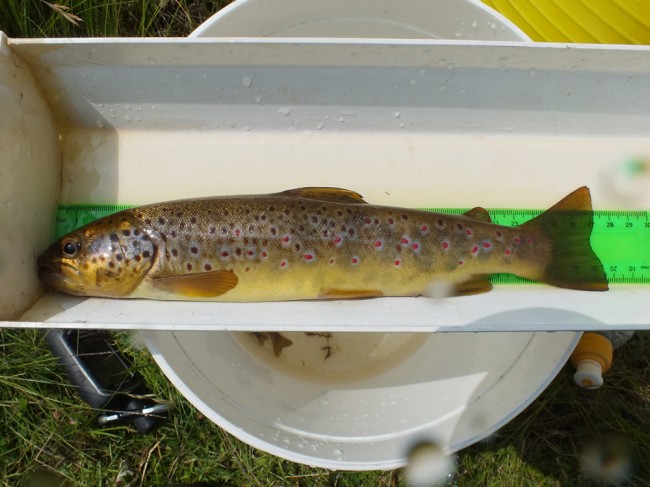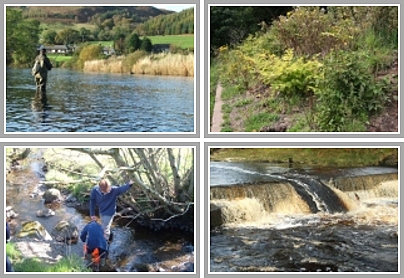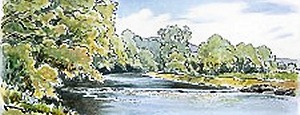It has been well reported in the past years that the River Ayr salmon stocks aren’t what they should be so in order to assess the productivity in the good areas, we have been revisiting some established sites that haven’t been surveyed for some time and also looking at new sites in particular areas where we lack knowledge . One burn that we haven’t fished before was the Polkebock that rises near the Slot Burn between Meanlour Hill and Middlefield Law. With the Greenock becoming increasingly important to salmon recruitment as the main stem River Ayr struggles, then it seemed sensible to have a look to see if salmon use the burn for spawning. After a short tramp across moorland in the sweltering heat, we picked a couple of sites and set about fishing. I’m pleased to report that we found that salmon are present and can penetrate well up the burn. The numbers recorded weren’t high however this is another burn that helps to boost the Greenock’s productivity and therefore is important to the whole system. We fished two sites, both in the lower 1.5km of the burn and both had salmon. The keeper informed me that he has watched salmon near the top of the burn so there doesn’t appear to be access problems. It will be interesting to see how many redds we can count at spawning time. There were good trout numbers too and some a decent size.

The largest trout we captured from the Polkebock Burn

Looking down on the Polkebock
Elsewhere on the river we have noticed that upper reaches have produced slightly better results than in recent years. This doesn’t mean that everything is rosy but I am encouraged by a few sites at least. Nether Wellwood has been under performing for a few years now but this years results were excellent despite the conditions of the gravel and the obvious enrichment. Underfoot the gravel was solid and immobile and this is probably due to the iron deposits that also cause the greenish colour in the water. I know SEPA feel this has been a long term problem for the upper Ayr but we have noticed this area deteriorate over the last 6 years or so. I remember looking over this bridge regularly watching shoals of grayling but you would be hard pushed to see anything now. The grayling don’t appear in our catches and anglers comment that they have disappeared from this area. There is a marked reduction in water quality downstream of the old Kames Colliery. The reed beds are doing a great job but obviously don’t catch everything from the old mine workings and over a very short distance the river changes colour and the gravels deteriorate.

The conditions we found at Nether Wellwood weren’t encouraging
Other areas that showed increases included Stairaird in the middle river and Old Howford Brig where we found improved fry numbers. There may be several reasons for this, not least that the flow is so low at the moment that the fish are more concentrated and therefore easier to catch but other factors such as improvements to water quality as a result of SEPA’s work on diffuse pollution, the reduced activity of Surface mining and the increased water levels of 2012 and early 2013 that may have diluted pollution and allowed more fish to reach the upper river could all be factors.

Very low flow at Old Howford Bridge
Our site at Stair is normally a parr site and this year was no exception but unusually we found several salmon parr that appeared to be smolting We also found similar parr at Oswalds bridge further downstream. If this is correct then these fish are heading to sea much later than the main smolt run and it would be great if we could work out where these fish were produced in the system although this may not be possible given the time and resources we have.

smolting
We paid a quick visit to the Ponesk to see if salmon had managed to spawn there last winter. I did see a salmon on one visit but only one so I hoped for good results. As Scottish Coal is in receivership at present, we only fished one site as we will not be paid for this survey but it is important to continue to monitor the recovery of the burn. We found salmon fry and parr although in low numbers but this is encouraging. salmon are using this burn and it is only a matter of time before numbers increase as water quality is good. The trees that were planted are doing well and it won’t be many years until this habitat looks much more natural.

The upper river lacked a timed site so we have established one downstream of the Ponesk confluence where there is good gravel and pool habitat nearby so we expect this area should be well used for spawning. We know the condition of this habitat has been poor and heavily coated with iron oxide and algae for a couple of years but on the day we visited, things were looking better. After electrofishing we ended up with a reasonable catch consisting mainly of salmon, very small salmon but salmon none the less. I think the smallest fry I’ve ever recorded came from this site at 27mm long!

Tiny salmon
Our egg box trials indicated that survival was poor in most main stem areas and although not conclusive it makes me wonder just how good this river could be if the problems that exist can be solved. I hope to repeat egg box trials on the Ayr and Doon again later this year as I think last years results raised many questions worth further investigation. I would also like to try experimental gravel cleaning in advance of spawning to see if productivity can be improved. I’m sure sites such as the new one downstream of the Ponesk would be ideal for this type of management.
The Lugar electrofishing surveys are still to be completed but with one exception appear to be as expected. The surprising result we had was downstream of the Ochiltree Weir where fry numbers were excellent for the first time in years. Again I suspect this may be linked to the very low flow concentrating the fish into a smaller area but there could be other reasons for the improvement too.
We will be electrofishing for a couple of months at least and eventually analyse the results in detail and produce our reports but in the meantime I’ll keep updating the blog with anything interesting that we find.


Good luck and may the force be with you!!
must be much better doing it this year as the sun is out and no rain the tans will be very good.
Hi very interesting results from electrofishing and idea,s on gravel cleaning etc,very impressed someone is coming up with some possible solutions .Fantastic and well thought out scheme
Keep up the good work ,well done
Perhaps a hatchery would help short term?
George,
thanks for the positive comments. I presume your suggestion of a hatchery is meant for the Ayr system? Currently there is a hatchery operating on the Ayr and I hope to help the team to devise a new strategy this year to ensure that areas failing are the only areas that fish are stripped from and ultimately restocked. It is important to realise that taking fish from productive areas and stocking them in other areas isn’t good practice and mixes the genes within the system with unknown results. It may be detrimental to areas where distinct genetic structuring occurs. During the FASMOP genetic structuring study, the Ayr showed more structuring than other Ayrshire Rivers and this shouldn’t be ignored. Electrofishing results from the Greenock upstream of the B746 indicate that despite good habitat and water quality, the area is not particularly well stocked. The culvert below the road could be the main problem but I also understand that salmon were regularly removed from this area for the hatchery. Perhaps if these fish hadn’t been removed over the years, this area would currently be more productive. No fish will be taken from this area this year and we will closely monitor whether there is any natural improvement in years to come.
Interestingly, the Girvan hatchery has been out of production for 4 seasons now and that is the river regularly showing the most improvement in Ayrshire. (We have still to complete this years efishing but so far results are fantastic!) Perhaps this is coincidence but I’m not so sure. The Tweed hatchery stopped in the 70’s and fish stocks rapidly improved. The Spey spent a fortune on hatchery work yet results indicated less than 2% of the catch was as a result of this work. Regular stocking of the Culroy Burn on the Doon failed for one reason or another to produce a self sustaining population of any consequence. Quite why this is so is unclear but we will be focussing on this burn in the next week or two in an attempt to see what’s going on. Nature given half a chance can do things far better than human efforts. Where I do believe we can make a difference is improving the habitat for spawning and I’m keen to try experimental gravel cleaning on the Ayr and Doon later this year. I’m sure in certain locations this will lead to improved spawning and egg survival but time will tell.
I’m always pleased to hear others thoughts and remain open minded on things so feel free to share your thoughts by email.
Stuart